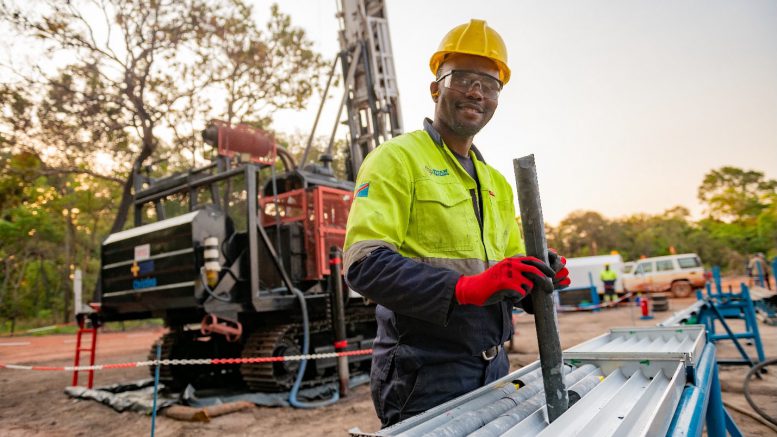Ivanhoe Mines (TSX: IVN; US-OTC: IVPAF) on Wednesday reported record third-quarter copper production but cut its full-year guidance by 6%, blaming power outages at its Kamoa-Kakula complex in the Democratic Republic of Congo.
The Toronto-based company lowered the copper guidance to 425,000–450,000 tonnes, from 440,000–490,000 tonnes. The disruptions stemmed from deficient transmission capacity and instability in the DRC’s southern grid, managed by state-owned Société Nationale d’Électricité. Delays in upgrading the Inga II dam’s transmission line and grid bottlenecks at the Kolwezi substation limited reliable power delivery.
Management is working to stabilize energy sources and expects smoother operations in 2025. Ivanhoe installed 220 megawatts of diesel backup. It aims to finish grid stabilization projects by mid-2025. It also plans to introduce solar power with battery storage within the next 18 months to complement hydropower.
“We’ve broken the back of the power problem, but some solutions will take longer to reach full capacity,” said COO Mark Farren on an investor conference call Wednesday. “We’re not only fixing grid issues but securing long-term power solutions.”
The disruptions wiped 36,500 tonnes of production this year. But, record copper output of 116,000 tonnes in the three months ended September brought in US$828 million. Adjusted profit was US$134 million, up from US$104 million a year ago.
This was despite delays from 16,000 tonnes of unsold inventory awaiting processing by external smelters. Chief financial officer David van Heerden said the company will “clear the backlog” once it begins stockpiling concentrate for its own smelter.
The company will finish its 94%-complete smelter and start it early next year. This will end reliance on third-party smelters. The new facility will refine blister copper on-site, cutting processing costs and boosting profitability.
At midday, Ivanhoe’s Toronto-traded shares 4.5% in the red Wednesday at $18.86, having traded in a band of $9.89-$21.32 over the past 12 months. It has a market capitalization of $26.6 billion.
The company says it remains on track to hit 600,000 tonnes of copper output by 2026.
At the Kipushi zinc mine the company slashed zinc production guidance in half to 50,000-70,000 tonnes. It said it had overcome early commissioning challenges and now targets achieving nameplate capacity by the first quarter. Still, the company forecasts exceeding feasibility production projections by 20% by mid-year.
Meanwhile, at the Platreef project in South Africa, the company deferred commissioning to late 2025 to focus on shaft development, preparing for the planned expansion and aiming to start platinum-group and base metals production by early 2026.

Kamoa-Kakula’s Phase 1 and Phase 2 concentrators. Credit: Ivanhoe Mines
Exploration update
Ivanhoe has budgeted US$90 million for exploration this year, focusing on the 2,654-sq.-km Western Forelands project near Kamoa-Kakula. Drilling is nearing the 70,000-metre target, with 11 rigs active across the site.
Ivanhoe executives hinted the Western Forelands could match or even surpass the scale of Kamoa-Kakula. “There’s much more than one or two mines in that place,” said one executive, adding that the area could host multiple large-scale operations.”
Makoko, believed to be the largest copper discovery outside Kamoa-Kakula in the last decade, has returned high-grade mineralization. In November last year Ivanhoe released an indicated resource on Makoko of 16 million tonnes at 3.6% copper plus 154 million tonnes inferred at 1.97% copper, using a 1.5% copper cut-off.
Analysts pressed Ivanhoe for more granular updates, but founder and co-chairman Robert Friedland, calling in from Riyadh, hinted at a major update late this year or early in 2025.
Friedland confirmed that Ivanhoe has no immediate plans to bring in a joint venture partner but left the possibility open: “We’ll proceed alone unless the right partner adds real value. We won’t rush a deal just to say we’ve made one.”
The company recently secured 336 sq. km of new licenses in highly prospective areas, with Friedland describing the ground as nearly “as important as the joint venture area with Zijin Mining at Kamoa-Kakula.” He suggested Western Forelands could anchor Ivanhoe’s future production strategy, noting that the existing infrastructure would support fast development.
Green edge
In Wednesday’s conference call Friedland called Western Forelands “the world’s greenest place to find high-grade copper,” benefiting from the DRC’s abundant hydroelectric power, allowing copper extraction with minimal carbon emissions.
He framed the Western Forelands as the future of sustainable mining with access to green energy, advanced machines, and high-grade copper.
Friedland also highlighted the Lobito rail corridor as a game changer for Ivanhoe’s operations in the DRC, emphasizing its potential to enhance both efficiency and sustainability.
“The Lobito corridor, running downhill from our operations at 4,500 feet above sea level to the Atlantic Ocean, will even generate electricity as it descends,” Friedland said. “It’s not just transport—it’s part of making our copper the greenest in the world.”
The corridor will let Ivanhoe transport copper to international markets. This will cut logistics costs and eliminate emissions from traditional transport. “Once the rail line is fully operational next year, it will cut scope three emissions and place Kamoa-Kakula and Western Forelands at the forefront of sustainable copper production,” Friedland added.


Be the first to comment on "Ivanhoe cuts copper forecast on DRC power woes, while Friedland touts new discoveries"